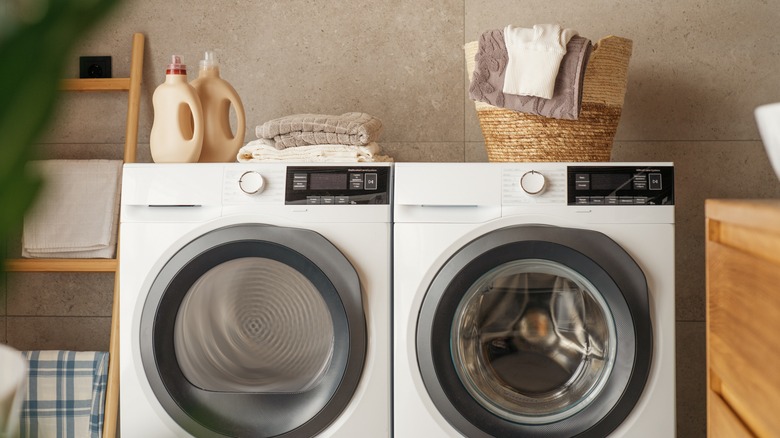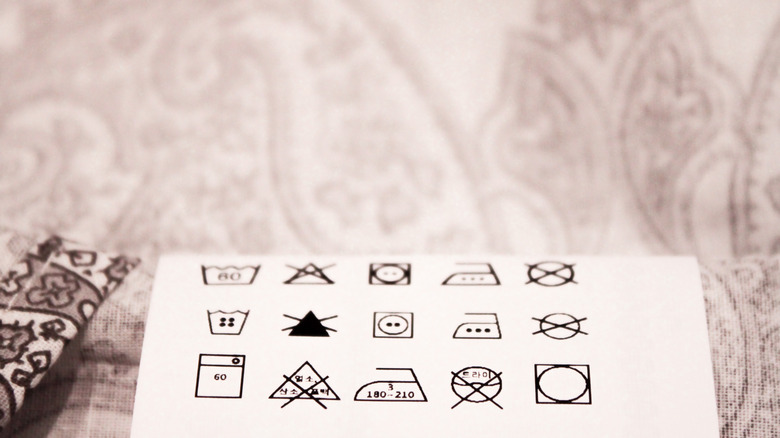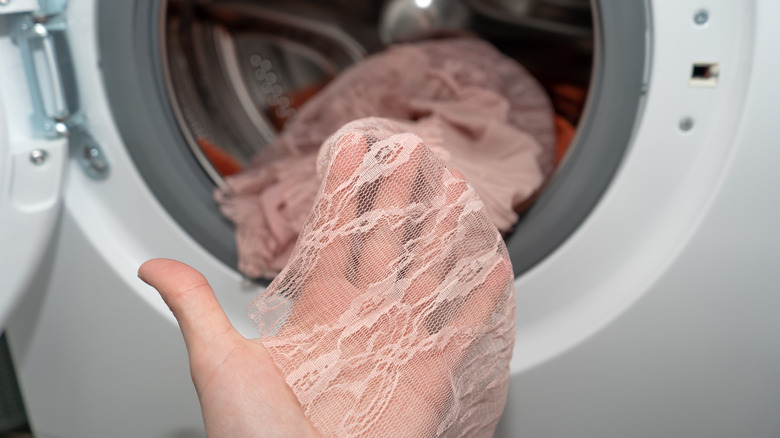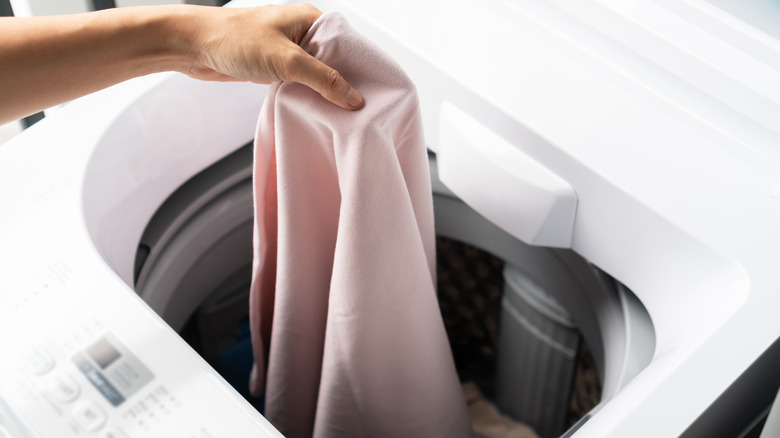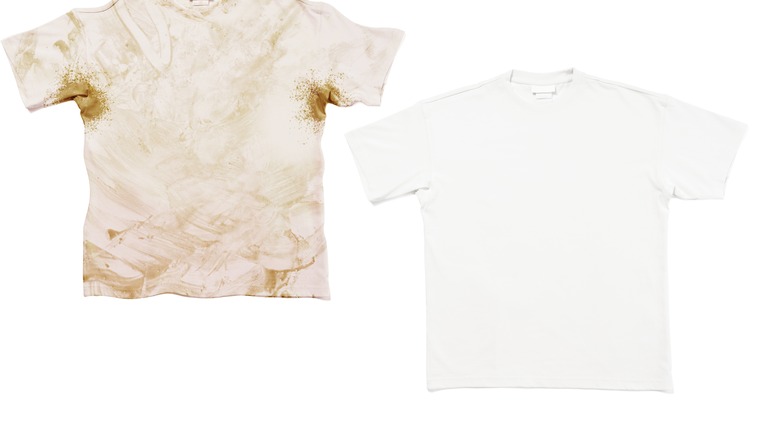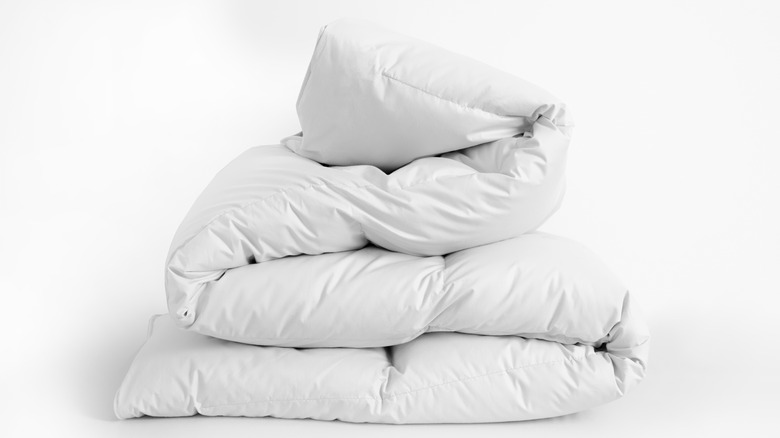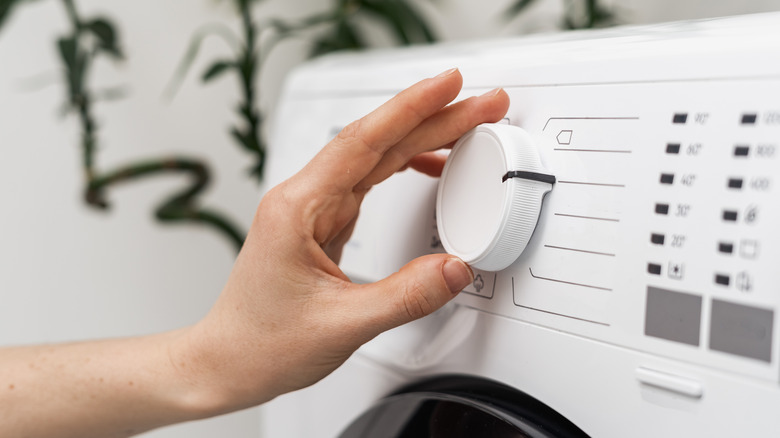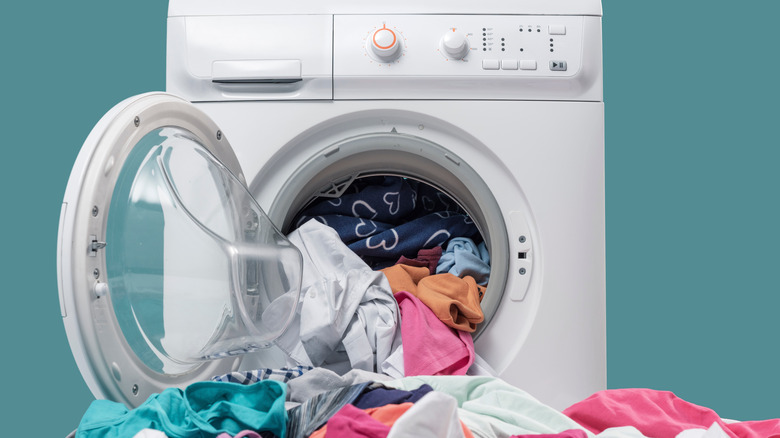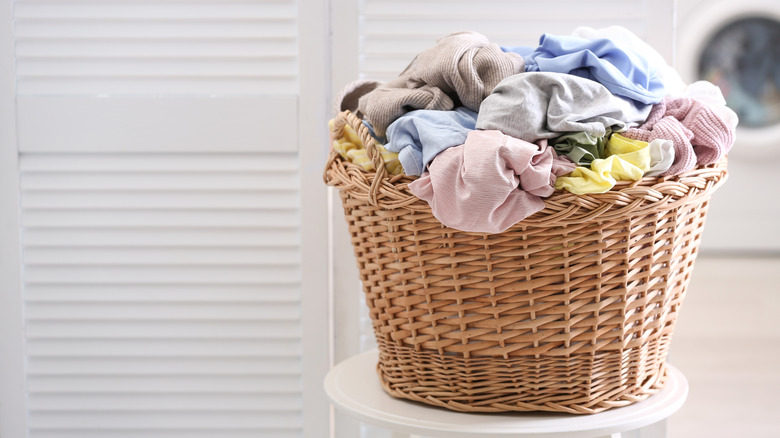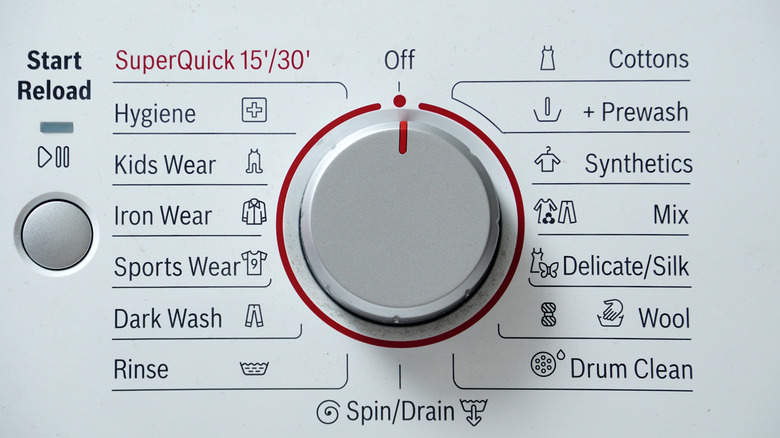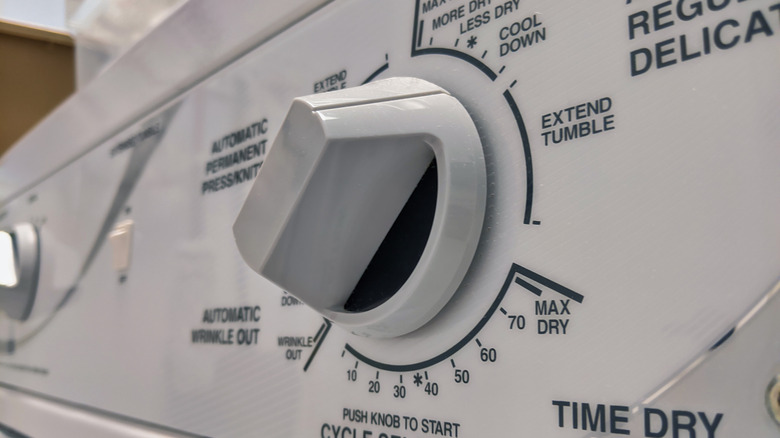All The Laundry Machine Settings Explained
Today's washers and dryers make it easy to take care of clothing and household linens made from a variety of fabrics. As modern machines become more effective, the quantity of cycle choices increases, and knowing which settings to choose can be tricky. Understanding the laundry machine settings will help you to save electrical energy, avoid damaging your clothing, and ensure that your clothes and household linens last for a long time.
To clean a load of laundry, your washing machine fills with water in which the detergent dissolves. Then, it agitates the clothing or linens in the soapy water, drains and rinses the load, and finally spins the laundry to squeeze out the remaining water. The settings that you choose dictate the water level, water temperature, speed of agitation and spinning, as well as the timing of the different phases in the overall cycle. After washing a load of laundry, you'll want to select the most suitable dryer setting. The proper choice of setting on your dryer ensures that your laundry dries in a timely manner without damaging the fabrics.
Understanding what the symbols on clothing tags tell you about laundry machine settings
With knowledge of a few symbols, you can look at the tags on clothing and household linens to determine the ideal laundry machine settings. Tide provides a helpful guide to the international laundry care symbols. A tub-of-water icon means that you can wash the piece, but an X through the tub of water means that it should not be washed. Alternatively, a hand in the tub of water indicates that hand-washing is the recommended method for cleaning the garment. A plain circle means to dry clean the piece, and an X through the circle tells you to nix that trip to the dry cleaners.
One dot in the tub-of-water icon indicates that you should choose a cold water temperature between 65 degrees and 85 degrees Fahrenheit. Two dots signify that warm water up to 105 degrees Fahrenheit is preferred, and three dots call for hot water up to 120 degrees Fahrenheit. A triangle symbolizes that a garment can be washed with bleach. An X through the triangle means to avoid bleach, and a triangle with diagonal lines through it tells you to use non-chlorine bleach, only. Finally, keep in mind that a plain tub-of-water symbol means to wash the piece on the normal setting. One line appearing beneath the tub of water tells you to select the permanent press setting, and two lines indicate that you should wash the garment on the delicate or gentle setting.
Delicate or gentle setting
Some delicate fabrics require washing with cool water and minimally abrasive action. For these fabrics, use the delicate or gentle wash setting. It provides cold water between 65 degrees and 85 degrees Fahrenheit. Additionally, the delicate cycle minimizes the speed of tumbling or agitation along with the speed and force of the spinning action. These restraints in heat, speed, and force result in the safe handling of delicate fabrics that cannot withstand abrasion. Use the delicate setting for lingerie, lace items, thin synthetics, and other fabrics that can be easily damaged.
Choosing the delicate or gentle setting on your washing machine is not the same as handwashing in a sink or tub. Due to the machine's agitation, it produces more stress on the fabric than if you were manipulating the garment by hand. However, when the tag on a garment indicates that hand-washing is recommended, it might be safe to launder the piece in the washing machine. It's really your call, and machine washing saves time and effort. For extra care, you can minimize the effects of agitation by placing the piece in a lingerie bag.
Permanent press or wrinkle control setting
Many of our modern-day clothing items come out wrinkle-free when they're washed on the permanent press setting. It uses warm water for washing and cold water for rinsing. The warm water relaxes the creases in fabrics, and the cold water helps to preserve the non-wrinkling or permanent-press finishes that manufacturers include in some fabrics. This water-temperature combination helps to extend the life of your apparel pieces.
After washing and rinsing, the wrinkle control cycle treats clothing gently. The speeds of agitation and spinning in this cycle are noticeably slower than in the normal or heavy-duty wash settings. This means that fabrics are less wrinkled as they tumble and spin. The entire cycle takes an average of only 30 minutes, reducing the stress on fabrics that longer settings can produce. Permanent press or wrinkle control are good choices for knits and synthetic fabrics like polyester, rayon, and acrylic. Although the permanent press setting is somewhat gentle, it is not a substitute for the delicate cycle when you're laundering delicate fabrics.
Normal setting
Based on its name, you might think that the normal setting should be used for almost all your laundry needs. However, our modern-day wardrobes include a broad array of fabric types that are too delicate for this cycle. In the normal setting, your washer heats the water to a high temperature, averaging between 120 degrees and 140 degrees Fahrenheit. After filling with hot water, the washer tumbles and spins the laundry at high speeds. Therefore the normal setting should be used only for clothing and linens that are durable enough to withstand the heat and agitation. On the other hand, it is an ideal setting for cleaning dirty laundry that shows a moderate amount of soil.
Use the normal cycle on your washer for cotton, denim, and sturdy fabric blends. Sheets and towels, cotton underwear, socks, and work clothes may be washed in the normal cycle. Additionally, it's a go-to cycle for washing whites with bleach.
Heavy duty or heavy soil setting
The heavy duty setting goes above and beyond the normal wash setting to yield maximum cleaning results. The cycle is longer than normal, allowing time for the hot water and detergent to lift heavy soil from the fabric's fibers. The water temperature reaches 130 degrees Fahrenheit or higher, and the washing machine's motor provides powerful, high-speed agitation and spinning. It's a setting that is too harsh for many fabrics, but the heavy soil cycle can't be beat for removing dirt and stains from durable fabrics that tolerate hot water and high-speed tumbling.
Select the heavy duty or heavy soil setting for clothing and household laundry items that get super dirty. These include jeans, sports jerseys, work clothes, towels, and tablecloths. The high-powered spinning effect is ideal for thick items like coats and jackets, squeezing out the maximum amount of water by the end of the cycle.
Bulky setting
Use this setting for bulky pieces of laundry like quilts, comforters, sleeping bags, throw rugs, and bath mats. Balancing the load is an important factor when you're washing large items that become heavy when wet. If a heavy load of laundry becomes unbalanced, it places extra stress on the machine's motor as it tries to run through the agitating and spinning portions of the cycle. The bulky cycle takes care of balancing the load by providing extra water and by tumbling and spinning at slower speeds to minimize agitation.
During the pre-wash stage of the bulky cycle, an ample amount of water fills the drum to fully submerge the large laundry items. Next, the cycle allows extra time for the bulky items to soak up the water and settle into a balanced position in the machine's wash tub or drum. During the washing portion of the bulky cycle, the machine allows the load to sit for a few minutes before rinsing with plenty of water to remove detergent residue from all parts of the large laundry items.
Speed wash, quick wash, or rapid wash setting
When you're in a hurry, the quick wash setting is a handy feature on your washing machine. Use it to refresh clothing items that you decide to wear at the last minute. A quick wash cycle can take as little as 14 minutes. The washing and rinsing portions of the cycle are shorter than normal, and the machine spins the load at a fast speed. This means that most of the water is squeezed out of the fabrics to allow for a quick drying time.
This setting is ideal for washing a few lightweight items that are not dirty. For example, you might employ the rapid wash setting to freshen up a shirt and a pair of pants that you want to wear immediately. However, you should not use the speed wash cycle for all your laundry needs. It simply will not do a thorough job of cleaning heavily soiled items or a large load of laundry. The typical water temperature for a rapid wash cycle is a cool 86 degrees Fahrenheit, but you can change the water temperature setting manually.
Whites and sanitizing settings
Some laundry items need hot water to kill bacteria. For example, you might want to sanitize baby clothes and linens or workout wear with sweat stains. The sanitizing cycle uses water heated to around 130 degrees to 150 degrees Fahrenheit. Along with the extra-hot water, this cycle agitates and spins the laundry at high speeds.
Similar to the sanitizing setting, the white setting allows you to add bleach to your laundry for the purpose of disinfecting and killing germs as well as maintaining the white color of the laundry items. Most washing machines feature a bleach dispenser compartment into which you pour liquid bleach. It's located either inside or on top of the machine. With a pump and a timer, the machine releases the bleach into the laundry tub or drum at the optimal time in the wash cycle. Bleach is a strong cleaning agent for sanitizing durable, white fabrics. However, it is a corrosive substance that might damage some fabrics and surfaces. Therefore, it's important to exercise caution when adding bleach to your wash cycle.
Rinse-and-spin and drain-and-spin settings
Most washing machine settings activate three cycles: the wash cycle, the rinse cycle, and the spin cycle. The rinse-and-spin setting eliminates the washing phase. It is useful when you want to simply rinse with clear water and squeeze out the excess water by spinning the load. For example, if you mistakenly add too much detergent to a load of laundry, you might want to rinse it one more time and spin it to remove the residual detergent and water. On the other hand, you might want to rinse and spin a heavily soiled load of laundry to loosen the dirt before you put it through a regular wash cycle.
The drain-and-spin cycle eliminates both the washing and rinsing phases of a regular cycle. It simply drains any standing water from the wash tub or drum and spins the load to remove any water that was absorbed by the fabrics. The drain-and-spin cycle is handy on occasions when bulky items remain too wet at the end of a regular washing cycle. Additionally, you might want to use it for squeezing water out of hand-washed items before hanging them to dry.
Understanding load size and water level
For best results, you'll want to load your washer with the appropriate amount of laundry. If you pack in too much laundry at one time, the items will not have enough room to move around in the soapy water during the wash cycle and to thoroughly rinse away the suds. When you're loading the laundry, keep in mind that a small load loosely fills the tub less than half full. A tub filled loosely to the halfway point represents a medium load, and when the laundry fills the tub ¾ full, it's a large load. According to Complete Appliance Repair & Service, the interior capacity of a full-size washer is 3-to-4 cubic feet. This means you can load 12 to 16 pounds of dirty laundry without stressing the machine. If you have a large capacity machine, its interior probably measures 5 or more cubic feet. With the enlarged capacity, you'll be able to wash 20 pounds of laundry in one load.
Utilizing a sensor and an automatic switch, many machines fill the wash tub or drum with water to the right level for any size load. However, you can manually select the water level with a dial or button on the machine. For a small load, the machine fills with water to about one-third full. A medium load receives enough water to fill the tub half full. For a large load, the machine releases water to fill the tub three-quarters full.
Selecting the right water temperature
To preserve the appearance and condition of various fabrics, you'll want to wash them in the most suitable water temperatures. Read the symbols on the laundry-care tags attached to your clothing and household linens before selecting the water temperature. Cold or cool water is in the range of 60 degrees to 80 degrees Fahrenheit. Warm water ranges from 86 degrees to 120 degrees. If you select hot water, it will be around 130 to 150 degrees.
Washing your laundry in cold water saves money. According to GE Appliances, your washing machine spends 75 to 90 percent of its total energy consumption on heating the water. Washing and rinsing in cold water results in fewer wrinkles, less fading, and minimized shrinkage. Delicate fabrics fare better in cold-water laundering than in warmer water temperatures. However, warm-water washing with a cold-water rinse is the preferred setting for knits, polyester, synthetics, and blended-fiber fabrics. For heavily soiled laundry and items that require sanitizing, choose the hot water setting. At higher temperatures, the water disinfects laundry items such as towels, bedding, underwear, and socks.
Understanding laundry cycle speeds
To select the right settings for the different fabrics in your laundry basket, it's helpful to understand the importance of cycle speeds. High speeds produce a greater degree of agitation in the wash and spin portions of the cycle. This agitation causes abrasion that might be too harsh for some fabrics. Think of how in ancient times, people washed their clothes by beating them against rocks in a river. In more recent history, washboards were used for scrubbing clothes in a tub of water. This gives you an idea of how agitation and abrasion help to loosen and remove dirt from fabrics. However, many of our modern-day fabrics would not stand up to that kind of treatment.
During the wash cycle, the tub or drum moves back and forth to agitate the clothes in the soapy water. Then, during the spin cycle, the drum rotates to extract water from the clothes via centrifugal force. Your washing machine can perform these functions at varying speeds. In the delicate setting, the machine uses slow speeds to avoid abrasion on the fabrics. For the permanent press or wrinkle control setting, moderate-speed agitation coupled with slow-speed spinning produce the best results. The normal setting uses high speeds for both agitation and spinning. When the bulky setting is selected, the machine uses slow speeds to avoid unbalancing the load.
Choosing the right dryer settings
After carefully selecting the best washer settings for your laundry, you'll want to follow up with the best dryer setting to get your clothing dry and fluffy without shrinking or fading. For many types of fabric, your best choices are medium or low heat settings. Most dryers offer heat selections ranging from air fluff to regular or heavy.
The air fluff setting tumbles the laundry with unheated air. It's a good choice for freshening clothing that you want to wear one more time before laundering. The delicate or gentle cycle uses low heat. This is the best choice for synthetic fabrics, blends, and stretchy knits. For colored fabrics and most clothing items, the medium heat of the permanent press setting is the preferred choice. On the regular or heavy setting, the machine uses high heat to quickly dry the durable cotton fabrics in towels, bedding, and denim jeans. Additionally, some dryers include a steam setting that uses warm, moist air to loosen wrinkles in fabrics. It's a useful choice to refresh a forgotten load of laundry that sits in the dryer for too long.
Although the settings on washing machines and dryers can seem confusing at first, they help to ensure that your laundry comes out in pristine condition. A little knowledge goes a long way as you make the most appropriate selections, allowing your laundry machines to operate at top efficiency.
